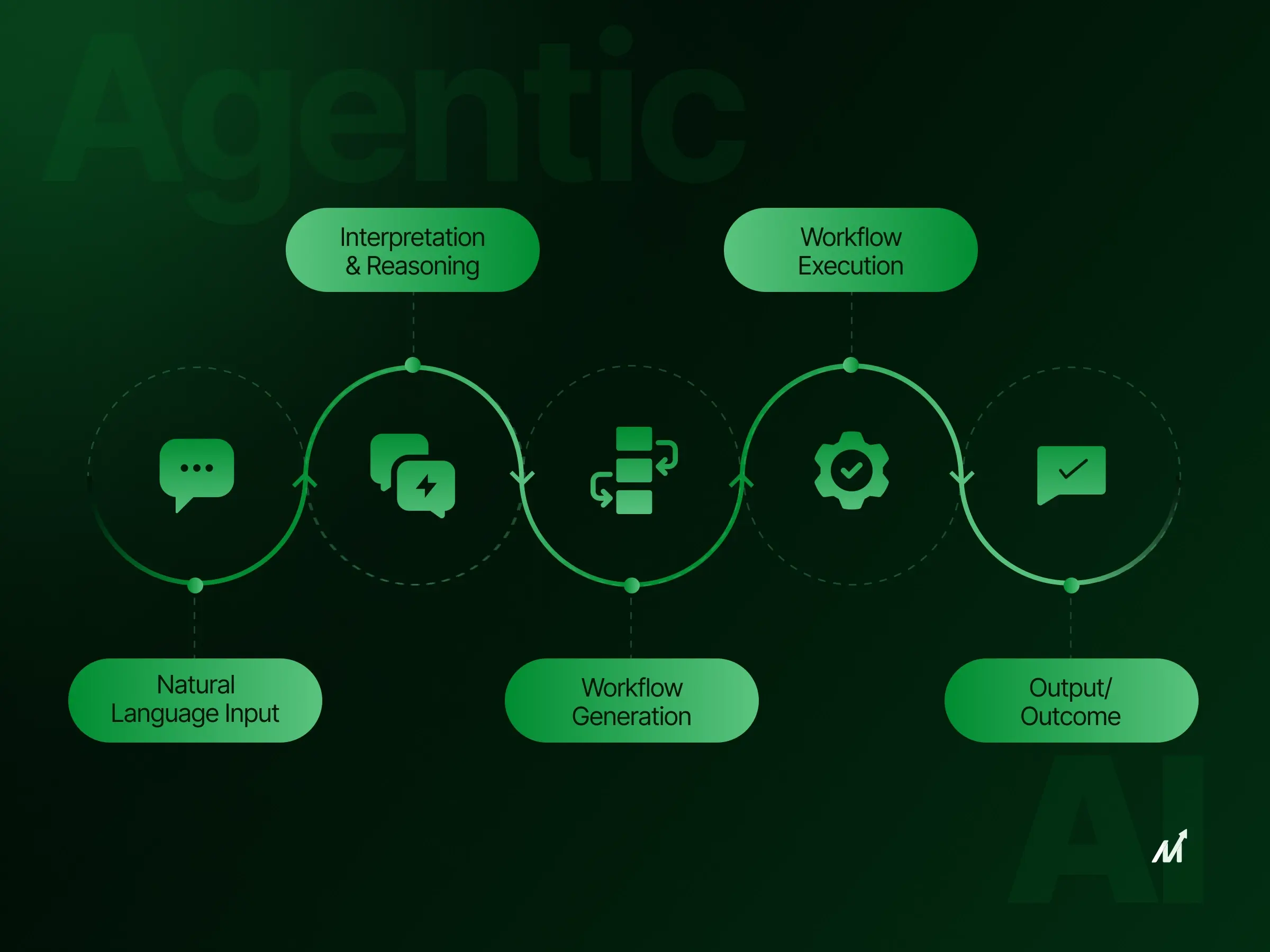Artificial intelligence is rapidly reshaping how enterprises innovate and scale operations. While traditional AI has long delivered value through automation and analytics, the rise of generative AI has extended its capabilities in three breakthrough areas: information synthesis, content generation, and natural language communication. McKinsey estimates that these advancements could unlock an additional $2.6 trillion to $4.4 trillion in economic value, on top of what traditional analytical AI already contributes.
Within this landscape, businesses are increasingly turning to agentic LLM architectures, AI systems designed to act more autonomously, make context-aware decisions, and integrate seamlessly into workflows. This transition reflects a growing need for intelligent systems that don’t just respond but proactively drive outcomes across industries.
What is Agentic LLM?
An agentic LLM is an advanced large language model designed to operate with autonomy and adaptability. Unlike traditional LLMs that generate responses only when prompted, agentic LLMs are capable of planning, reasoning, and executing multi-step tasks with minimal human intervention.
These systems act more like intelligent agents than passive tools, they can retain context, interact with enterprise systems, and make decisions based on goals rather than just inputs. This makes them ideal for businesses seeking to move beyond static automation toward dynamic, outcome-driven AI solutions.
Traditional LLMs vs. Agentic LLMs
While traditional LLMs excel at generating text, answering questions, and summarizing information, they are largely reactive, producing outputs only when prompted. Agentic LLMs, on the other hand, represent the next evolution: they are proactive, context-aware, and capable of managing multi-step tasks autonomously. This distinction marks a shift from AI as a tool to AI as an intelligent collaborator within enterprise workflows.
| Feature | Traditional LLMs | Agentic LLMs |
| Task Execution | Respond to single prompts | Handle multi-step, autonomous tasks |
| Context Awareness | Limited to short-term conversation | Retain and apply context across workflows |
| Integration | Primarily standalone | Designed to integrate with enterprise systems |
| Adaptability | Static output, requires re-prompting | Learns and adapts to evolving needs |
| Human Supervision | High, needs constant prompting | Low, can operate with minimal oversight |
| Use Cases | Content generation, Q&A, summarization | Customer service, process automation, decision support |
Key Benefits of Agentic LLM Architectures
Enterprises adopting agentic LLM systems are seeing advantages that go far beyond what traditional AI can deliver. These benefits are driving their rapid adoption across industries:
- Autonomous Problem-Solving: Agentic LLMs can break down complex objectives into smaller steps, plan solutions, and execute them without constant human input.
- Contextual Intelligence: They retain knowledge from past interactions, enabling more accurate, relevant, and personalized responses over time.
- Seamless Enterprise Integration: Designed to connect with CRM, ERP, HR, and other enterprise systems, they streamline workflows end-to-end.
- Scalability Across Functions: From customer service to supply chain management, agentic LLMs can scale across departments while maintaining efficiency.
- Improved Productivity: By reducing repetitive oversight, they free human teams to focus on innovation and strategic decision-making.
- Enhanced Customer Experience: Their ability to resolve issues proactively and deliver personalized interactions translates into higher customer satisfaction and loyalty.
Use Cases of Agentic LLMs Across Industries
The shift toward agentic LLM architectures isn’t theoretical, it’s already reshaping how industries operate. Here are some of the most impactful applications:
- Customer Service: Acting as intelligent support agents, they resolve customer issues end-to-end without escalation, reducing call volumes and improving satisfaction.
- Finance: Automating fraud detection, compliance monitoring, and investment analysis with faster, more accurate insights.
- Healthcare: Assisting clinicians by reviewing medical records, suggesting diagnostic pathways, and personalizing treatment recommendations.
- Retail & E-Commerce: Powering personalized product recommendations, supply chain optimization, and automated order management.
- Manufacturing & Logistics: Monitoring equipment health, predicting downtime, and managing logistics flows with real-time decision-making.
Challenges and Considerations in Adopting Agentic LLMs
While the benefits of agentic LLM architectures are clear, enterprises also need to approach adoption thoughtfully. Key considerations include:
- Data Security and Privacy: Since these systems integrate with enterprise data, ensuring compliance with regulations like GDPR or HIPAA is essential.
- Implementation Costs: Building and maintaining agentic LLMs may require significant investment in infrastructure, integration, and training.
- Governance and Oversight: Even autonomous systems need frameworks for accountability, audit trails, and ethical use.
- Change Management: Employees and stakeholders must adapt to working alongside intelligent agents, which often requires cultural and workflow shifts.
- Model Reliability: While agentic LLMs are more autonomous, they still require guardrails to minimize errors and prevent undesired outcomes.
The Future Outlook of Agentic LLMs
As businesses accelerate digital transformation, agentic LLM architectures are expected to play a central role in shaping enterprise innovation. Unlike traditional tools that simply respond to queries, agentic systems will evolve into strategic collaborators capable of driving decisions, optimizing operations, and creating new business models.
Industry experts predict that the next wave of enterprise AI will emphasize:
- Greater Personalization: delivering hyper-tailored solutions to customers and employees.
- Autonomous Operations: reducing the need for manual oversight in complex workflows.
- Cross-Industry Adoption: spreading from early adopters in tech and finance to sectors like healthcare, education, and government.
- Continuous Learning: leveraging feedback loops to become smarter and more aligned with enterprise goals over time.
The long-term trajectory points to agentic LLMs moving beyond operational efficiency to becoming key drivers of competitive advantage.
Final Thoughts
The rise of agentic LLM architectures marks a turning point in enterprise AI adoption. Businesses are no longer satisfied with systems that merely respond to prompts — they are seeking AI agents that can reason, plan, and act with autonomy. From customer service to supply chain optimization, these architectures are already proving their ability to deliver measurable value.For organizations, the opportunity lies in moving beyond pilots and embracing agentic LLMs as core enablers of growth and efficiency. Those that succeed will not only reduce costs and streamline operations but also unlock new possibilities for innovation and competitive advantage.





